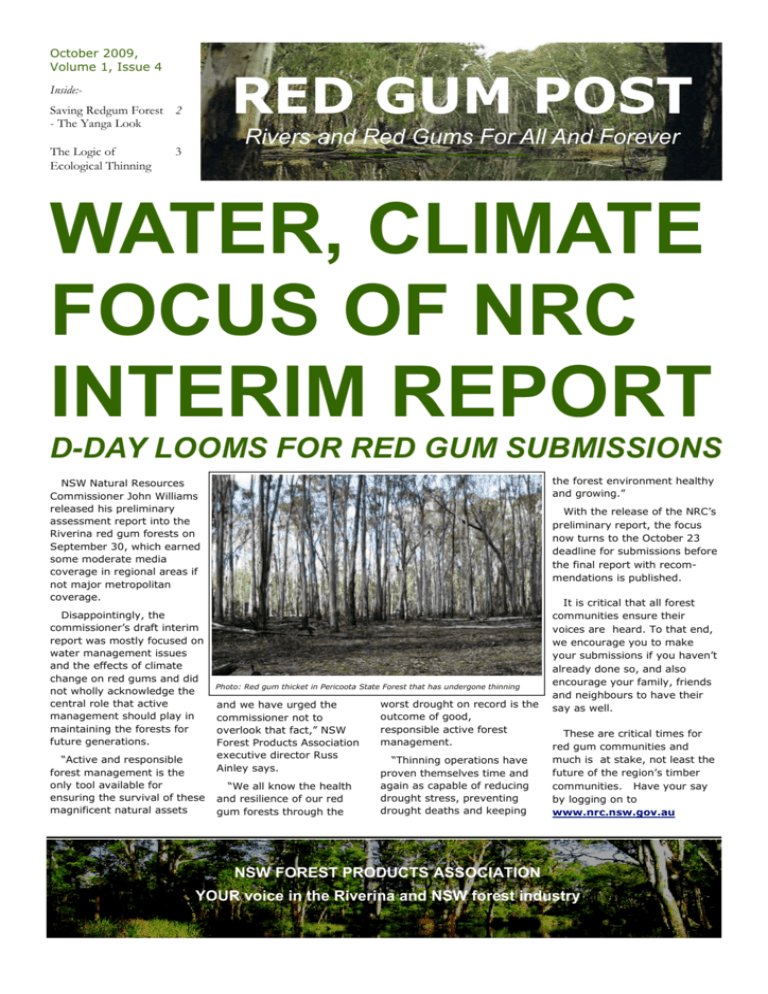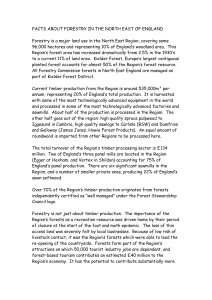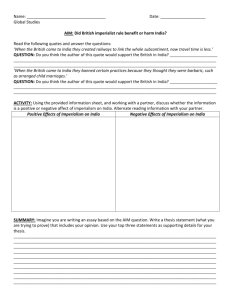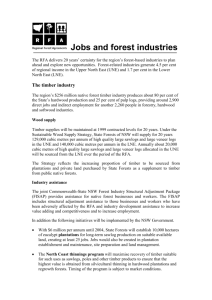Red Gum Post - edition 4
advertisement

October 2009, Volume 1, Issue 4 RED GUM POST Inside:Saving Redgum Forest 2 - The Yanga Look The Logic of Ecological Thinning Rivers and Red Gums For All And Forever 3 WATER, CLIMATE FOCUS OF NRC INTERIM REPORT D-DAY LOOMS FOR RED GUM SUBMISSIONS the forest environment healthy and growing.” NSW Natural Resources Commissioner John Williams released his preliminary assessment report into the Riverina red gum forests on September 30, which earned some moderate media coverage in regional areas if not major metropolitan coverage. Disappointingly, the commissioner’s draft interim report was mostly focused on water management issues and the effects of climate change on red gums and did not wholly acknowledge the central role that active management should play in maintaining the forests for future generations. “Active and responsible forest management is the only tool available for ensuring the survival of these magnificent natural assets With the release of the NRC’s preliminary report, the focus now turns to the October 23 deadline for submissions before the final report with recommendations is published. Photo: Red gum thicket in Pericoota State Forest that has undergone thinning and we have urged the commissioner not to overlook that fact,” NSW Forest Products Association executive director Russ Ainley says. “We all know the health and resilience of our red gum forests through the worst drought on record is the outcome of good, responsible active forest management. “Thinning operations have proven themselves time and again as capable of reducing drought stress, preventing drought deaths and keeping It is critical that all forest communities ensure their voices are heard. To that end, we encourage you to make your submissions if you haven’t already done so, and also encourage your family, friends and neighbours to have their say as well. These are critical times for red gum communities and much is at stake, not least the future of the region’s timber communities. Have your say by logging on to www.nrc.nsw.gov.au NSW FOREST PRODUCTS ASSOCIATION YOUR voice in the Riverina and NSW forest industry Page 2 RED GUM POST Rivers and Red Gums For All And Forever October 2009, Volume 1, Issue 4 The ‘Yanga’ Look Why the NRC needs to consider past examples Yanga Station, now Yanga National Park, once Balranald's own jewel of the Nile, is now a shadow of its former self. competing for what little water there is. In some places, the Yanga is overstocked by more than 500 per cent. With 150km of Murrumbidgee River frontage, the station encompassed an area 80,000 hectares in size, with in excess of 17,000ha of well-managed red gum forest. In short, more than 60 per cent of the forest is dead at a cost to NSW taxpayers of $35 million. Up until 2005, the red gums were selectively harvested on a sustainable, limited basis under the supervision of a responsible forester: an operator with over 40 years' experience of managing renewable forest resources in both the government and private sectors. The timber provided employment for local families, not to mention carbon positive products like furniture and structural timbers – everyday items used by the vast majority of everyday people in country AND city areas. Most of all, the red gums were healthy and growing. In fact, when former premier Bob Carr bought Yanga in 2005 for $35 million, he commented on how well the property and the forest had been cared for. Before and after: Locally, we have a saying to describe forested areas that are clearly dying through neglect: we say they've got 'the Yanga look'. This week, the Natural Resources Commissioner, who is currently assessing the Riverina red gum forests, released his interim report. Above: A biodiversity wasteland—dead trees at Yanga National Park; Below: Silvicultural thinned red gum forests—now thriving even in drought conditions It is vital that he acknowledges the damage done to places like Yanga: areas that are locked up and turned into national parks under the pretence of conservation. It is vital that the Commissioner acts to safeguard not only the health of these magnificent forests but also the economic health of so many communities that are totally dependent on the resource. For that is what we are talking about. A resource. Other keywords often conveniently overlooked include sustainable. Renewable. Then, too weak to resist the Selective. Responsible. allure of city-based green preferRegenerative. Carbon-positive. ences, he arbitrarily locked the The red gum is one of the forests up. The local sawmill fastest regenerating species, stopped operating, the people who worked there told they were while Australian forests are among the world's best and no longer required. healthiest. It was a major blow to the town What would you rather have: of Balranald and to the renewworld-leading, standard-setting, able red gum industry within the ethical timber harvesting operaRiverina. tions or a renewable, sustainable Today, Yanga is dying. The forestry industry shut down in forest is becoming increasingly favour of imported, illegallychoked with too many trees harvested timber products? When he locked up Yanga, Bob Carr said don't worry about the job losses, don't worry that the Wakool shire is losing 10 per cent of its rate base (national parks do not pay rates), don't worry about the viability of the businesses that have been affected, don't worry about the future of the community. Change and Water (DECC) know how to look after them. Trouble is, they don't. Their interest is only a national green agenda where country towns and small businesses are not relevant. In their view, the people have no importance and should have no say in the Forest Assessment being conducted by the Tourism will fix everything, NRC. he said: 50,000 visitors per There are hundreds of year. thousands of dead or dying red gums in Yanga right now Don't worry about the and more are dying every health of the beautiful red day, while the park managgum forests: the National ers sit on their hands doing Parks and Wildlife Service (NPWS) and Department of nothing. Environment, Climate (continued on page 3) October 2009, Volume 1, Issue 4 ‘Yanga’ Look If the trees were livestock, the RSPCA would have prosecuted the current managers long ago. These forests need to be sustainably managed, before we lose them. The NPWS and DECC should not be allowed to manage Yanga any longer. We do not need any more red gum national parks. What we need is active management and multiple-use forests on a sustainable basis. Only a NSW Forest Agreement safeguarding the future of selective timber harvesting will suffice. Responsible forest management through limited, selective and sustainable timber harvesting is the only tool available for ensuring the survival of these magnificent natural assets. Ken O’Brien Riverina Chair, Board Member Forest Products NSW Above: Overstocked red gums. Below: An ecologically-thinned thicket RED GUM POST Page 3 Rivers and Red Gums For All And Forever The ‘Logic’ of Ecological Thinning By TODD GELLETLY In the red gum community of BarhamKoondrook, Forests NSW and local industry members are on the front foot to ensure the survival of the over-stocked red gum forests in the worst drought on record. These products are also an environmentallyfriendly alternative to concrete sleepers, fossil fuels and electricity guzzling split systems used for heating. Areas that have been ecologically thinned less than 12 months ago have responded extremely well to less competition for moisture The forests around Barham have been hard and soil nutrient; their crowns, once stressed hit by the current drought, which is showing and dying off, are now flourishing and full of no signs of breaking, compounded by the over leaves. The only sign of any sort of human population of trees from earlier flood events. intervention from an area thinned in SeptemThe once healthy vibrant stands of red gum ber 2008 is the remnants of some paint on trees are dying at an alarming rate and withretained and habitat trees. out human intervention, the problem will Meanwhile there are kangaroos, wallabies, worsen. Fortunately, Forests NSW has had emus and an abundance of bird life including the foresight and the backing of industry, to the majestic wedge-tailed eagle, all frolicking conduct ecological thinnings in targeted areas in the area as if it had never seen a human to reduce the impact of drought and unsusbeing. tainable tree population to improve the health and long term survival of these magnificent “This area that has been thinned hasn’t forests. seen a flood since 1996 but I can safely say that if this area doesn’t see a flood for anForests NSW formulates a Harother 13 years, that the retained trees will vest Plan ensuring all survive only because of active management” environmental considerations are said Ken O’Brien, a third generation member covered. Once the Harvest Plan of the red gum industry, with 36 years experiis approved, it is given to an ence in the forest. experienced local State Forest Officer who then hand-picks trees The reduction in tree population as a result for retention: Habitat trees, of ecological thinning vastly improves the Recruitment trees (next health of retained trees, trees that 12 months generation of Habitat trees) and, ago were dying through a lack of moisture of course, trees for have survived and are now actually growing. harvesting. This is a fantastic result that people from all From the harvested trees, indifferent points of view simply cannot argue dustry is able to produce highwith; they would be foolish if they actually grade saw logs for furniture, came and saw what we’ve done and said, ‘It’s structural timber for projects not improving the forest’. such as the magnificent Echuca Since the first trials of silvicultural, or ecoWharf, rail sleepers and landlogical thinning, back in 2003, industry has scape timber, as well as chipmoved with the times using the latest techwood and mulch, which is also nology in not only the planning but also the sold as a result of ecological thinharvesting. ning; products which store Technology such as satellite imaging and carbon and reduce the effects of GPS assist Forests NSW in targeting the areas climate change on our planet. Page 4 October 2009, Volume 1, Issue 4 RED GUM POST Rivers and Red Gums For All And Forever TCA chief executive JIM ADAMS writes: Last week I spent two days accompanying the NRC tour of the region from Deniliquin to Swan Hill. To its credit, the Rees Government has, at least to this stage, not bowed to the cynical Bob Carr-promoted calls to reserve the river red gum forests and has appointed the NRC to conduct a study of “the river red gum and woodland forests within the NSW Riverina IBRA and the South West Cypress Forests in order to determine conservation outcomes and a sustainable future for the forests, the forestry industry and local communities in the region”. Of interest, during the tour it was clear to all present that the river red gum forests are in a seriously threatened state and that this threat is a direct result of the drought, with many of the largest trees dead or dying and many areas of unthinned regrowth also under serious drought stress. By contrast, while also clearly under stress, areas of thinned managed forest are in far better health. What was also clear to all present was that the only way to address this situation was to take measures to manage the moisture regimes within the forests. The options to do this are either watering by flooding or active management of the water demand of the forests by thinning. Much discussion during the tour revolved around how in the absence of significant sustained rainfall, this could not be achieved without the active management of these forests. This in turn lead to much discussion about “outcome determined” management models as opposed to “tenure based” management models. Many in our timber communities have long drawn attention to how in many ways simply locking up an area of forest into a reserve does not protect and in fact often destroys the very conservation values that are sought to be protected, and that in fact in many cases the ongoing active management of these forests would do far more to conserve those conservation values while still supporting industry and communities. The river red gum forests are a very clear and undeniable example of the validity of this position which is further under lined by the RAMSAR approved management regimes conducted by Forests NSW in the NSW river red gum forests. As renowned Victorian river red gum forest ecologist and forester Barrie Dexter put it during the tour, “These forests require an average of about 650mm of water per annum to survive; the natural rainfall in this region is about 450mm per annum. In the past, most years, periodic flooding has made up the difference often enough for them to survive. In the absence of flooding or rainfall, thinning of the forests is the only other way to manage water demand and have any hope of ensuring their survival.” One might add also “and the survival of the industry and communities who rely on these forests for their viability including many farmers who supplement their incomes during drought through the river red gum industries.” It was pleasing during the tour to note that at least the NRC clearly had an open mind to these issues. Of more concern is the item in the terms of reference of the commission which reads: “The commission should have regard to the following as they relate to the bioregion: - Opportunities for ongoing and future employment within affected local communities” In this context, one cannot help but note the unproven claims made by Bob Carr in his NSW FOREST PRODUCTS ASSOCIATION: The Logic of Ecological Thinning that need thinning the most. The two processing machines currently thinning red gums are equipped with fully computerised measuring equipment that measures diameter and length and automatically selects the most valuable piece of timber available from each log to maximise the production of a higher grade of log. Ecological thinning can also be credited with lowering the available fuel load if fire was to strike, increasing the prospects of the fire being contained. It also decreases the chance of a wild fire entering the crown of the retained trees, again allowing for greater control of a fire. The alternative is a wild fire that wipes out all in its path including rare and endangered species of flora and fauna that, ironically, are heavily protected in the Harvest Plan produced by Forests New South Wales and members of the industry. Ecological thinning and the red gum timber industry—part of the solution, not the problem. TODD GELLETLY is a second generation member of the industry with 13 years’ experience in the red gum forests. recent foray into this debate in which he makes claims associated with tourism replacing lost employment in the Brigalow and South East Forest region to name, just a couple of the regions devastated by National Park declaration of his government. The facts are that this alleged bonanza of tourism development has not happened in either of these regions, or, for that matter, in any of the other regions around Australia where this offset to the declaration of a reservation of previously productive forest has been used. In the river red gum forests there is already a significant tourism sector which is highly unlikely to increase if they are relegated to reserve status to slowly die. TCA has asked the NRC to consider asking the proponents of any such claims around tourism to substantiate those claims when made. River Red Gum forests – for all – forever! TIMBER COMMUNITIES AUSTRALIA: Level 2, 60 York Street, 24 Napier Close, Sydney NSW 2000 Deakin ACT 2600 PO Box Q953 PO Box 289 QVB NSW 1230 DEAKIN WEST ACT 2600 Phone: (02) 9279-2344 Phone: (02) 6282-2455 Fax: (02) 9279-2355 Fax: (02) 6282-2314 fpa@nswfpa.asn.au jim.adams@tca.org.au The NSW Forest Products Association was established in 1906 as the representative organisation of the forest and forest products industry in NSW. Timber Communities Australia exists to encourage the sensible, balanced multiple use of our forests for the benefit of all Australians.







